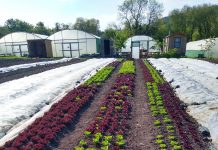It’s all kicking off again! Well…just about. We will begin to sow our first seeds this month, starting off with peppers, tomatoes, beetroot, lettuce and other salad leaves (like broad beans for tips, mustards, kales, chervil), shallots, spring onions and spring cabbage. However, we have heated benches to help maintain the right sorts of temperature for seed germination for these crops, so if you don’t have anything like this don’t be tempted to start sowing too early. Sometimes the weather at this time of year can charm us into being a bit overexcited, but be cautious—it does not pay to sow things too early. Light levels are still low, and seedlings can grow very leggy and weak. It is generally better to wait a few weeks and start sowing in March for a lot of things. Even waiting a few weeks to sow tomatoes may mean the first harvest are just a couple of days later, and the effort to keep the seedlings healthy and strong through February is not always worth it.
Almost all of the crops that we grow we sow into module trays first (the only crops that we sow direct into the soil are carrots, parsnips, radish and a few mustard salads). We fill the trays up with organic seed compost, making sure that it is well pushed down into each module (especially around the edges). We then press down with our fingers (or a special tool that does all the modules at once) to make a little impression in each module into which we sow the seed. Many of the crops that we grow we sow multiple seeds per module so that we can plant out a clump of plants at a time. We do not thin these out, but each seedling pushes the others out of the way a little and creates its own space to grow. The result is a mini bunch that can be harvested in one go and saves time thinning plants. It also means that the beds can be hoed a lot more thoroughly as we set out the plants at even distances allowing the hoe to pass between them rather than having a dense line of plants. This works well with beetroot & chard, peas (all 2-3 seeds per module), spring onions (10 seeds per module), shallots and many of the different salad leaves (3-5 seeds per module). We sow just one seed per module for cabbages, broccoli, kale and most other brassicas, lettuce (as pills), chicory and endive. Lettuce seeds that are not in pills (a clay coating around the seed) are sown in an open tray and pricked out once the two seed leaves (cotyledons) appear, we also do this with tomatoes and peppers.
After sowing the seeds into trays we usually lightly cover them with vermiculite which helps to maintain more constant moisture levels and temperature. We then place the seed trays in a tray of water, so that they are watered from below. This ensures that all of the compost is moist and well-watered, and takes away any chance of washing the seeds away from watering overhead. The only seeds we don’t do this with are larger seeds like beans, peas, cucumbers and squash which can rot if they get too wet. Lastly, we put the soaked seed trays onto the heat benches and cover them with polystyrene sheets. This again maintains more constant levels of humidity and temperature. We look under the polystyrene twice a day, and at the first signs of germination we take it off (take it off after 3 or so days for seeds from the umbellifer family—parsley, chervil, dill, fennel, as they need more light to germinate). We then take the trays off the heated benches to harden them off a little and make space for new sowings. The plants are ideally planted out once the first lot of true leaves have come up. All of our early plantings outdoors (which start around the end of March) are covered in horticultural fleece to keep them protected from the wind and cold until around May.
WHAT TO SOW THIS MONTH: If you have a heated propagator in a naturally well-lit place: peppers, tomatoes, lettuce, beetroot, shallots, spring onions, spring cabbage, salad leaves (see above). If you do not have a heated propagator, best leave sowing until March.
WHAT TO PLANT THIS MONTH:
OUTSIDE: Wait until next month!
INSIDE: Most of the indoor space should have been planted up with overwintering leaves, herbs, and early crops like spring onions, early garlic and peas.
OTHER IMPORTANT TASKS THIS MONTH: If the weather dries, continue preparing beds for the spring by mulching with compost. Wash any polytunnel or glasshouse to make sure maximum levels of light are getting through to the crops. Try to finish off that winter job list, so that you are fully prepared for the onslaught of spring!








